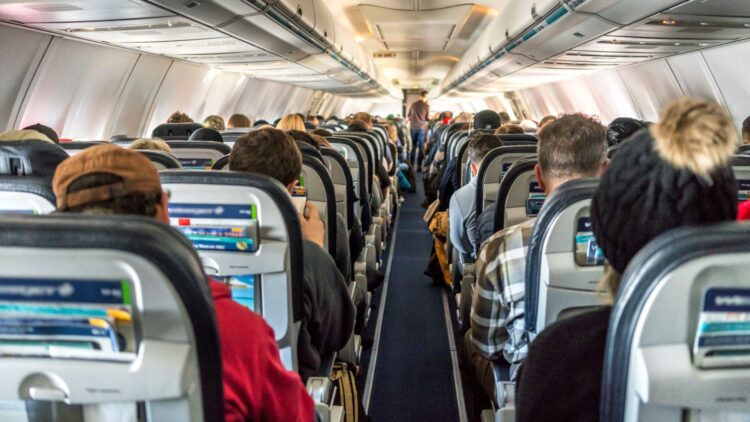Although commercial aviation remains one of the safest modes of transportation in the world, the sense of vulnerability of being suspended thousands of feet in the air awakens in many travelers an inevitable perception of risk. This apparent fragility (being surrounded only by air) generates a natural uneasiness that transcends objective safety data.
The airplane and its seat usually give a lot of respect to air travel, but if we take a look at the data on air accidents, according to the FFA (Federal Aviation Administration), the airplane is one of the safest means of transport. So, in the face of this fear, many travelers, wishing to actively improve their chances in the event of an emergency, may have asked themselves: is there a seat that offers greater protection?
Officially, aviation authorities maintain that there are no definitively safer positions, as each incident is unique. However, studies and expert analysis reveal certain statistical patterns that could be considered when choosing a seat for those seeking to optimize every aspect of their safety.
El avión y asiento suelen dar mucho respeto junto a los viajes en avión, pero si echamos un vistazo a los datos de accidentes aéreos hay que atender, según a la FFA (Administración Federal de Aviación), que el avión es de los medios más seguros. Así pues, antes este temor, muchos viajeros, con el deseo de mejorar activamente sus probabilidades en caso de una emergencia, quizás se hayan preguntado: ¿existe algún asiento que ofrezca mayor protección?
Oficialmente, las autoridades aeronáuticas sostienen que no hay posiciones definitivamente más seguras, ya que cada incidente es único. Sin embargo, estudios y análisis de expertos revelan ciertos patrones estadísticos que podrían considerarse al elegir asiento para quienes buscan optimizar cada aspecto de su seguridad.
Flying: reassuring safety statistics
But before we get into the details, it’s important to put things in context: flying remains one of the safest forms of transportation. According to a study published in 2024 in the Journal of Air Transport Management, the probability of dying on a commercial flight in the United States is 1 in 13.7 million.
To put this in perspective, a Washington Post analysis reveals that, for every 1 billion miles traveled, there are 7.28 deaths by car, compared to only 0.07 by plane.
The more reassuring statistic is that 94% of serious airliner accidents between 2001 and 2017 had full survival rates, according to the U.S. National Transportation Safety Board (NTSB).
What is the safest seat?
While there is officially no “golden seat” guaranteed to survive, studies and crash analyses reveal interesting patterns.
“It all depends on the dynamics of the crash,” Daniel Kwasi Adjekum, an aviation safety researcher at the University of North Dakota, explained to Live Science.
As the science outlet reports, if the crash does not result in a total catastrophe and the plane impacts at a low angle or leaves the runway, the forward section absorbs most of the impact, suggesting that positioning oneself in the rear might offer better prospects for survival.
A 2015 analysis of Federal Aviation Administration (FAA) accident data cited by Time magazine supported this theory, showing that passengers seated in the rear third of the plane had the lowest fatality rates.
In fact, when the NTSB investigated 20 accidents since 1971 (with fatalities and survivors), it found that those seated in the rear of the plane had a 69% chance of staying alive, while those in the front had only a 49% chance. Passengers seated around the wing had a 56% chance.
Window, middle or aisle?
Interestingly, it doesn’t just matter which part of the plane you sit in, but also which seat in the row. According to Time’s analysis of FAA air accident data from 1985 to 2000, people sitting in the center seats in the back of the plane had a 28% fatality rate, while the least safe were the aisle seats in the middle third of the cabin, with a 44% fatality rate.
As an analysis cited by Forbes points out, center seats offer greater protection because passengers are protected by people seated on either side of them.
Other advantages of the center section
Cheng-Lung Wu, a professor at the University of New South Wales, points out that the center section of the aircraft, near the wings, has some important additional advantages: it is structurally reinforced and is often closer to emergency exits. That proximity can shave seconds off evacuation time, which can mean the difference between escaping or not.
However, these same seats are located directly above the fuel tanks. “Although aircraft are supposed to empty their tanks before landing, these pods can still emit smoke or catch fire in the event of an accident,” warns Adjekum. In such cases, rapid evacuation becomes even more critical.
Add to all this a dose of chance. The reality is that survival is highly dependent on the type of accident. For example, in the 1989 crash of United Flight 232 in Sioux City, the 184 people who survived (out of 269) were seated further forward in the plane, contradicting the general rule.

